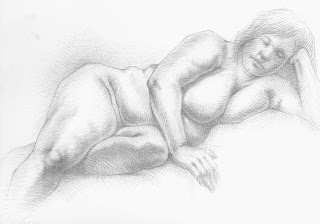On Friday I had the privilege of seeing Michelangelo’s
sculpture ”David-Apollo” (1530) at the National Gallery of Art in Washington,
DC. This beautiful marble sculpture is
on loan from the Museo Nazionale del Bargello, in Florence, to celebrate 2013,
the Year of Italian Culture. The name of
the sculpture alludes to the conflicting stories that the figure is David,
slayer of Goliath or Apollo, god of
light and sun.
Michelangelo's "David-Apollo", marble, 1530.
Michelangelo's "David-Apollo" Detail
Michelangelo (1474-1564) was a master of the High Renaissance and best known for his colossal masterpiece “David” (1501-1504) which
dominates the Galleria dell’ Accademia in Florence. Michelangelo is considered
to be one of the greatest artists of all time.
His creations in painting, sculpture, architecture and drawing are among
the greatest masterpieces of Western art.
Michelangelo's "David", marble, 1501-1504
While “David” is a large, highly polished piece the
“David-Apollo” is an unfinished, smaller than life size sculpture. This unfinished quality allows the viewer
insight into Michelangelo’s process.
According to the National Gallery of Art, Michelangelo used a point
chisel to rough out the forms and a claw chisel to refine the figure. The roughened areas formed with the point
chisel can be seen on the back of the figure and the tree stump. This juxtaposition of the refined and
roughened marble later inspired 19th century French artist Auguste Rodin. Below is one of Rodin’s sculptures to demonstrating
this technique.
Auguste Rodin, "Galatea", marble, 1889
While Michelangelo posed his “David” in a position of contrapposto,
“David-Apollo” displays a twisting pose called serpentinata.
I highly recommend a visit to the National Gallery Art
before March 3, 21013 when “David-Apollo” returns to Florence.



























.JPG)






